A Review of Uncertainties in Power Systems—Modeling, Impact, and Mitigation
Abstract
1. Introduction
2. Impact of the Uncertainties
2.1. Uncertainties Affecting the Generation
- The utilization of induction generators in wind turbines inherently leads to the absorption of reactive power from the grid. For fixed-speed turbines, fluctuations in reactive power output can result in voltage fluctuations. Nevertheless, modern variable-speed turbines, e.g., DFIGs, can offer reactive power support through suitable interfacing methods [31].
- Fast ramping and frequent start-up generation units are required to provide reserves for wind and solar power fluctuations, which could also increase the operational cost of power systems [32,33]. Moreover, the lack of system flexibility with integrated wind and solar power has the potential to trigger blackouts in the power system. In February 2021, the cold period in Texas led to the icing of the turbine blades, which prevented the turbines from operating, causing a total power outage [34]. Researchers in [35] found that over 60% of solar penetration will cause blackout due to load imbalance according to the simulation of the Kythnos power system. Consequently, protective measures are essential to maintain system frequency and prevent cascading failure events.
- Transmission congestions can occur when the wind and solar generation is away from the load center [36]. Moreover, the high-RES penetration level will lead to higher transmission capacity, thereby increasing distribution losses.
- Due to the intermittency and variability of solar and wind generation, it is challenging to rely solely on these resources to meet load demand during peak hours, especially during cloudy or windless periods. In this case, the paper emphasizes the importance of demand-side ancillary services in Section 4, which can be achieved by either encouraging customers to adjust energy usage during peak hours or establishing VPP to optimize load curtailment.
2.2. Uncertainties Affecting the Network Assets
2.3. Uncertainties Affecting the Communication Link
3. Uncertainty Modeling
3.1. Uncertainties Affecting the Generation
3.2. Wildfires and Rainfall
3.3. Asset Management for Aging Assets
3.4. Cyber-Attacks Detection
- Attacks on AGC: The purpose of AGC is to adjust the power output of the generators within an area to maintain the frequency and power exchange via the tie line. Given that the time resolution of AGC control signals operates on a time scale of seconds, it cannot afford to utilize elaborate data-validation algorithms [84].
- Attacks on state estimation: State estimation is crucial for operational decisions for a smart grid. The motivation for leading attacks on state estimation varies from causing blackouts to gaining financial profit from the market.
- Attacks on the energy market: Cyber-attacks on the energy market can be achieved by denial of service or injecting wrong data, e.g., jamming of price signals.
- Attacks on voltage control: Compared to the system frequency, voltage stability is a major concern in long distribution networks. LTC transformers are widely applied to improve voltage stability in response to load variation. The control topology for LTC makes it vulnerable to man-in-the-middle attacks.
4. Mitigation Approaches
4.1. Uncertainties Affecting the Generation
4.2. Uncertainties Affecting the Network Assets
- If the local network is connected to the grid, the power capacity shortage can be compensated by emergency power imports from the grid given the fact that the transmission feeder has available capacity beyond the scheduled import power amount [92].
- Minimization of potential load shedding during the power capacity shortage can be achieved by the emergency discharge and rescheduling of ESSs for both grid-connected and off-grid local networks [93].
- Implementing various scheduling lead times, e.g., 5 min and 30 min ahead, to determine the charging and discharging profiles of ESSs based on generation and demand forecasts.
- Implementing the real-time network reconfiguration which dynamically adjusts the configuration of the electrical network to optimize its performance and respond to the uncertainty events. This process typically occurs in real time to enhance the overall reliability and efficiency of the power system.
- Annual line and easement inspections: Qualified technicians will conduct thorough inspections of all lines, assets, and easements following the outlined process and evaluation criteria in “Lines Practices and Procedures”.
- Tower-climbing inspections: Scheduled at intervals of three, six, or nine years, these inspections are tailored to the probability of asset failure in specific areas, considering factors like bushfires.
- Tower corrosion monitoring: Tower legs and lattice members which might be influenced by previous weather-related events are monitored. Corrosion assessment and grading adhere to established standards with results recorded for subsequent maintenance scheduling and replacement activities.
- Targeted asset replacement: Combining data from condition monitoring and line inspections, the identification of necessary targeted asset replacements, such as insulators, conductors, and ground wires, is carried out.
4.3. Uncertainties Affecting the Communication Link
4.4. Emerging Technologies
5. Limitations and Possible Future Directions
5.1. Limitation for MCMC
- Regulatory Framework: Regulatory frameworks and market designs may not fully account for the unique characteristics of RESs, such as their variability. Existing market structures and mechanisms may not incentivize the desired response to manage uncertainty.
- Transmission and Grid Constraints: Limited transmission capacity and grid constraints can exacerbate the challenges of integrating RESs, leading to uncertainty in power flows and frequency control. Future improvements require the information exchange between DNSPs and RESs operators.
- Artificial Intelligence: Many AI models, especially deep learning models, operate as black boxes, making it challenging to understand how they arrive at specific decisions. This lack of transparency can hinder trust and make it difficult to explain data-driven outcomes.
5.2. Limitations for Defining the Weather Regions
5.3. Limitations for Asset Management
- Data Accuracy and Availability: CBRM heavily relies on accurate and reliable data for assessing asset conditions. Inaccuracies or insufficient data can compromise the effectiveness of the risk management process.
- Complexity of Degradation Processes: Predicting future conditions and performance is challenging due to the complexity of degradation processes. Some degradation mechanisms may not follow predictable patterns, making it difficult to precisely estimate asset deterioration.
- Assumption Sensitivity: CBRM involves making assumptions about the relationships between HI, POF, and COF. The accuracy of results is sensitive to the validity of these assumptions, and deviations can impact the reliability of risk assessments.
- Limited Predictive Ability for Catastrophic Events: CBRM may not be well suited for predicting rare but catastrophic events. Extreme events, such as natural disasters, may have consequences that are challenging to quantify accurately, leading to potential underestimation of risks.
6. Conclusions
Author Contributions
Funding
Data Availability Statement
Conflicts of Interest
Abbreviations
| AMI | Advanced metering infrastructure |
| D-FCAS | Demand-side frequency control ancillary service |
| RES | Renewable energy resource |
| LMP | Locational marginal price |
| AI | Artificial intelligence |
| PV | Photovoltaic |
| MG | Microgrids |
| VPP | Virtual power plant |
| ERCOT | Electric Reliability Council of Texas |
| SCADA | Supervisory control and data acquisition |
| AR | Autoregressive |
| MA | Moving-average |
| ARMA | Autoregressive moving average model |
| SARIMA | Seasonal autoregressive integrated moving average |
| ARIMA | Autoregressive integrated moving average |
| LR | Linear regression |
| SVM | Support vector machine |
| BPN | Backpropagation network |
| LSTM | Long short-term memory |
| RNN | Recurrent neural network |
| ANN | Artificial neural network |
| MSE | Mean square error |
| RMSE | Root mean square error |
| MAE | Mean absolute error |
| MAPE | Mean absolute percentage error |
| NMAE | Normalized mean absolute error |
| IID | Independent and identically distributed |
| MCMC | Markov chain Monte Carlo |
| ML | Machine learning |
| IMFR | Incremental multiplier of failure rate |
| FWI | Fire weather index |
| FFDI | Forest fire danger index |
| CBRM | Condition-based risk management |
| HI | Health index |
| POF | Probability of failure |
| COF | Consequences of failure |
| AGC | Automatic generation control |
| LTC | Load tap changing |
| CDBN | Conditional deep belief network |
| ESS | Energy storage system |
| DRCC | Distributionally robust chance constrained |
| SCC | Scenario-based chance constrained |
| MINLP | Mixed integer nonlinear programming |
| CPS | Cyber–physical system |
| DMS | Distribution management system |
| MCC | Microgrid central controller |
| PHS | Pumped hydro storage |
| CAES | Compressed air energy storage |
| SOC | State of charge |
| DLR | Dynamic line rating |
| DC | Direct current |
| AC | Alternating current |
| SOCP | Second-order cone programming |
| DFIG | Doubly fed induction generators |
| CNN | Convolutional neural network |
| RPS | Renewable portfolio standard |
| acf | Autocorrelation function |
| Probability distribution function | |
| GAN | Generative adversarial network |
| CVaR | Conditional Value-at-Risk |
| LC | Load controller |
| MSC | Micro-source controller |
| IMG | Interconnected microgrid |
| RegD | Dynamic regulation |
| BESS | Battery energy storage system |
| HPWH | Heat pump water heater |
| DNSP | Distributed network service provider |
References
- Schroeder, P.W. The nineteenth century system: Balance of power or political equilibrium? Rev. Int. Stud. 1989, 15, 135–153. [Google Scholar] [CrossRef]
- Liu, Z. Global Energy Interconnection; Academic Press: Cambridge, MA, USA, 2015. [Google Scholar]
- Carrasco, J.M.; Franquelo, L.G.; Bialasiewicz, J.T.; Galván, E.; Portillo, R.; Prats, M.M.; León, J.I.; Moreno-Alfonso, N. Power-electronic systems for the grid integration of renewable energy sources: A survey. IEEE Trans. Ind. Electron. 2006, 53, 1002–1016. (In English) [Google Scholar] [CrossRef]
- Bublitz, A.; Keles, D.; Zimmermann, F.; Fraunholz, C.; Fichtner, W. A survey on electricity market design: Insights from theory and real-world implementations of capacity remuneration mechanisms. Energy Econ. 2019, 80, 1059–1078. (In English) [Google Scholar]
- Rice, E.B.; AlMajali, A. Mitigating The Risk of Cyber Attack on Smart Grid Systems. Procedia Comput. Sci. 2014, 28, 575–582. (In English) [Google Scholar] [CrossRef]
- Inquiry into the National Electricity Market. Available online: https://www.accc.gov.au/system/files/Inquiry%20into%20the%20National%20Electricity%20Market%20-%20May%202022%20report%2813880615.1%29.pdf (accessed on 11 November 2023).
- AlMajali, A.; Rice, E.; Viswanathan, A.; Tan, K.; Neuman, C. A Systems Approach to Analysing Cyber-Physical Threats in the Smart Grid. In Proceedings of the 2013 IEEE International Conference on Smart Grid Communications (SmartGridComm), Vancouver, BC, Canada, 21–24 October 2013; pp. 456–461. (In English). [Google Scholar]
- Zhang, Y.; Wang, J.X.; Wang, X.F. Review on probabilistic forecasting of wind power generation. Renew. Sustain. Energy Rev. 2014, 32, 255–270. (In English) [Google Scholar]
- Roald, L.A.; Pozo, D.; Papavasiliou, A.; Molzahn, D.K.; Kazempour, J.; Conejo, A. Power systems optimization under uncertainty: A review of methods and applications. Electr. Power Syst. Res. 2023, 214, 108725. (In English) [Google Scholar]
- Borunda, M.; Rodríguez-Vázquez, K.; Garduno-Ramirez, R.; de la Cruz-Soto, J.; Antunez-Estrada, J.; Jaramillo, O.A. Long-Term Estimation of Wind Power by Probabilistic Forecast Using Genetic Programming. Energies 2020, 13, 1885. (In English) [Google Scholar]
- Chandramowli, S.N.; Felder, F.A. Impact of climate change on electricity systems and markets—A review of models and forecasts. Sustain. Energy Technol. Assess. 2014, 5, 62–74. (In English) [Google Scholar]
- Sathaye, J.; Shukla, P.R.; Ravindranath, N.H. Climate change, sustainable development and India: Global and national concerns. Curr. Sci. India 2006, 90, 314–325. (In English) [Google Scholar]
- Climate Change Impacts on Power Systems. Available online: https://www.preventionweb.net/news/climate-change-impacts-power-systems (accessed on 13 October 2023).
- How Does Weather Affect the Electrical Grid. Available online: https://marketscale.com/industries/building-management/how-does-weather-affect-the-electrical-grid/ (accessed on 13 October 2023).
- Handayani, K.; Filatova, T.; Krozer, Y. The Vulnerability of the Power Sector to Climate Variability and Change: Evidence from Indonesia. Energies 2019, 12, 3640. (In English) [Google Scholar] [CrossRef]
- Anadon, L.D.; Baker, E.; Bosetti, V. Integrating uncertainty into public energy research and development decisions. Nat. Energy 2017, 2, 17071. [Google Scholar]
- Bhusal, N.; Gautam, M.; Abdelmalak, M.; Benidris, M. Modeling of Natural Disasters and Extreme Events for Power System Resilience Enhancement and Evaluation Methods. In Proceedings of the 2020 International Conference on Probabilistic Methods Applied to Power Systems (PMAPS), Liege, Belgium, 18–21 August 2020. (In English). [Google Scholar]
- Stock, S.; Babazadeh, D.; Becker, C. Applications of Artificial Intelligence in Distribution Power System Operation. IEEE Access 2021, 9, 150098–150119. (In English) [Google Scholar] [CrossRef]
- Brusentsev, V.; Vroman, W. Disasters in the United States: Frequency, Costs, and Compensation; WE Upjohn Institute: Kalamazoo, MI, USA, 2017. [Google Scholar]
- Increasing Frequency and Intensity of Extreme Weather Events. Available online: https://www.epa.nsw.gov.au/your-environment/climate-change/trends/extreme-weather-events (accessed on 13 December 2023).
- Hart, D.; Birson, K. Deployment of Solar Photovoltaic Generation Capacity in the United States; Office of Energy Policy and Systems Analysis, U. S. Department of Energy: Washington DC, USA, 2016.
- Nazma Yeasmin, S. Performance of a Low Cost Circular Arc Horizontal Axis Wind Turbine. Master’s Thesis, Bangladesh University of Engineering and Technology, Dhaka, Bangladesh, 2009. Available online: http://lib.buet.ac.bd:8080/xmlui/bitstream/handle/123456789/861/full%20Thesis.pdf?sequence=1&isAllowed=y (accessed on 13 October 2023).
- Renewable Energy. Available online: https://ourworldindata.org/renewable-energy#citation (accessed on 23 October 2023).
- 2022 Integrated System Plan (ISP). Available online: https://aemo.com.au/energy-systems/major-publications/integrated-system-plan-isp/2022-integrated-system-plan-isp (accessed on 23 October 2023).
- Holttinen, H.; Meibom, P.; Orths, A.; Hulle, F.v.; Ensslin, C.; Hofmann, L.; McCann, J.; Pierik, J.; Tande, J.O.; Estanqueiro, A. Design and Operation of Power Systems with Large Amounts of Wind Power, first results of IEA collaboration. In Proceedings of the EWEC’2006-European Wind Energy Conference & Exhibition, Athens, Greece, 27 February–2 March 2006; pp. 1–15. [Google Scholar]
- Pieper, C.; Rubel, H. Electricity storage: Making large-scale adoption of wind and solar energies a reality. In Balanced Growth: Finding Strategies for Sustainable Development; Springer: Berlin/Heidelberg, Germany, 2011. (In English) [Google Scholar]
- Beier, J.; Thiede, S.; Herrmann, C. Energy flexibility of manufacturing systems for variable renewable energy supply integration: Real-time control method and simulation. J. Clean. Prod. 2017, 141, 648–661. (In English) [Google Scholar] [CrossRef]
- Anvari, M.; Lohmann, G.; Wächter, M.; Milan, P.; Lorenz, E.; Heinemann, D.; Tabar, M.R.R.; Peinke, J. Short term fluctuations of wind and solar power systems. New J. Phys. 2016, 18, 063027. (In English) [Google Scholar]
- Kahwash, F.; Maheri, A.; Mahkamov, K. Integration and optimisation of high-penetration Hybrid Renewable Energy Systems for fulfilling electrical and thermal demand for off-grid communities. Energy Convers. Manag. 2021, 236, 114035. (In English) [Google Scholar]
- Smith, J.C.; Milligan, M.R.; DeMeo, E.A.; Parsons, B. Utility wind integration and operating impact state of the art. IEEE Trans. Power Syst. 2007, 22, 900–908. (In English) [Google Scholar]
- Albadi, M.H.; El-Saadany, E.F. Overview of wind power intermittency impacts on power systems. Electr. Power Syst. Res. 2010, 80, 627–632. (In English) [Google Scholar] [CrossRef]
- Mladenov, V.; Chobanov, V.; Georgiev, A. Impact of Renewable Energy Sources on Power System Flexibility Requirements. Energies 2021, 14, 2813. (In English) [Google Scholar]
- Zipf, M.; Möst, D. Impacts of volatile and uncertain renewable energy sources on the German electricity system. In Proceedings of the 2013 10th International Conference on the European Energy Market (EEM), Stockholm, Sweden, 27–31 May 2013; pp. 1–8. [Google Scholar]
- Towoju, O.A.; Oladele, O.A. Electricity Generation from Hydro, Wind, Solar and the Environment. Eng. Technol. J. 2021, 39, 1392–1398. [Google Scholar]
- Rikos, E.; Tselepis, S.; Hoyer-Klick, C.; Schroedter-Homscheidt, M. Stability and Power Quality Issues in Microgrids Under Weather Disturbances. IEEE J. Sel. Top. Appl. Earth Obs. Remote Sens. 2008, 1, 170–179. (In English) [Google Scholar] [CrossRef]
- Steen, D.; Goop, J.; Göransson, L.; Nursbo, S.; Brolin, M.; Sarasini, S.; Kåberger, T. Challenges of integrating solar and wind into the electricity grid. In Systems Perspectives on Renewable Power; Chalmers University of Technology: Gothenburg, Sweden, 2014; pp. 94–107. [Google Scholar]
- Cost Pass through Application 2019–2020 Bushfire Disaster Event. Available online: https://www.aer.gov.au/system/files/Endeavour%20Energy%20-%202019-20%20bushfire%20disaster%20event%20cost%20pass%20through%20-%20Application%20-%20August%202020.pdf (accessed on 1 December 2023).
- Serrano, R.; Carvalho, M.R.; Araneda, J.C.; Alamos, O.; Barroso, L.; Bayma, D.; Ferreira, R.; Moreno, R. Fighting against Wildfires in Power Systems: Lessons and Resilient Practices From the Chilean and Brazilian Experiences. IEEE Power Energy Mag. 2022, 20, 38–51. (In English) [Google Scholar]
- Clements, D.; Mancarella, P. Systemic modelling and integrated assessment of asset management strategies and staff constraints on distribution network reliability. Electr. Power Syst. Res. 2018, 155, 164–171. (In English) [Google Scholar] [CrossRef]
- Moseidjord, A. The California electricity crisis. Energy J. 2003, 24, 143–145. (In English) [Google Scholar]
- Cleveland, K. “SIGNIFICANT BREAKING WORSE” The Fukushima Nuclear Crisis as a Moral Panic. Crit. Asian Stud. 2014, 46, 509–539. (In English) [Google Scholar] [CrossRef]
- Avizienis, A.; Laprie, J.C.; Randell, B.; Landwehr, C. Basic concepts and taxonomy of dependable and secure computing. IEEE Trans. Dependable Secur. Comput. 2004, 1, 11–33. (In English) [Google Scholar] [CrossRef]
- Lessons from the Massive United Kingdom Power Outage. Available online: https://www.govtech.com/blogs/lohrmann-on-cybersecurity/lessons-from-the-massive-uk-power-outage.html#:~:text=According%20to%20another%20source%20(Euronews,Great%20Britain%20said%20on%20Saturday (accessed on 15 December 2023).
- Shair, J.; Xie, X.R.; Wang, L.P.; Liu, W.; He, J.B.; Liu, H. Overview of emerging subsynchronous oscillations in practical wind power systems. Renew. Sust. Energy Rev. 2019, 99, 159–168. (In English) [Google Scholar]
- Ghafouri, M.; Karaagac, U.; Ameli, A.; Yan, J.; Assi, C. A Cyber Attack Mitigation Scheme for Series Compensated DFIG-Based Wind Parks. IEEE Trans. Smart Grid 2021, 12, 5221–5232. (In English) [Google Scholar] [CrossRef]
- Haque, N.I.; Shahriar, M.H.; Dastgir, M.G.; Debnath, A.; Parvez, I.; Sarwat, A.; Rahman, M.A. Machine learning in generation, detection, and mitigation of cyberattacks in smart grid: A survey. arXiv 2020, arXiv:2010.00661. [Google Scholar]
- Ten, C.W.; Liu, C.C.; Manimaran, G. Vulnerability Assessment of Cybersecurity for SCADA Systems. IEEE Trans. Power Syst. 2008, 23, 1836–1846. (In English) [Google Scholar]
- Amin, M.; El-Sousy, F.F.M.; Aziz, G.A.A.; Gaber, K.; Mohammed, O.A. CPS Attacks Mitigation Approaches on Power Electronic Systems With Security Challenges for Smart Grid Applications: A Review. IEEE Access 2021, 9, 38571–38601. (In English) [Google Scholar] [CrossRef]
- Meenal, R.; Binu, D.; Ramya, K.C.; Michael, P.A.; Kumar, K.V.; Rajasekaran, E.; Sangeetha, B. Weather Forecasting for Renewable Energy System: A Review. Arch. Comput. Methods Eng. 2022, 29, 2875–2891. (In English) [Google Scholar]
- Torres, J.F.; Hadjout, D.; Sebaa, A.; Martínez-alvarez, F.; Troncoso, A. Deep Learning for Time Series Forecasting: A Survey. Big Data 2021, 9, 3–21. (In English) [Google Scholar] [CrossRef] [PubMed]
- Chang, W.-Y. A literature review of wind forecasting methods. J. Power Energy Eng. 2014, 2, 161. [Google Scholar] [CrossRef]
- Voyant, C.; Notton, G.; Kalogirou, S.; Nivet, M.-L.; Paoli, C.; Motte, F.; Fouilloy, A. Machine learning methods for solar radiation forecasting: A review. Renew. Energy 2017, 105, 569–582. [Google Scholar]
- Project 7: Microgrid Impact Study. Available online: https://c4net.com.au/wp-content/uploads/2022/08/49.07-Final_report_P7_v3.pdf (accessed on 25 October 2023).
- Chau, T.K.; Yu, S.S.; Fernando, T.; Iu, H.H.C. Demand-Side Regulation Provision From Industrial Loads Integrated With Solar PV Panels and Energy Storage System for Ancillary Services. IEEE Trans. Ind. Inform. 2018, 14, 5038–5049. (In English) [Google Scholar] [CrossRef]
- Dubey, A.K.; Kumar, A.; Garcia-Diaz, V.; Sharma, A.K.; Kanhaiya, K. Study and analysis of SARIMA and LSTM in forecasting time series data. Sustain. Energy Technol. Assess. 2021, 47, 101474. (In English) [Google Scholar]
- Meenal, R.; Selvakumar, A.I. Assessment of SVM, empirical and ANN based solar radiation prediction models with most influencing input parameters. Renew. Energy 2018, 121, 324–343. [Google Scholar]
- Livieris, I.E.; Pintelas, E.; Pintelas, P. A CNN-LSTM model for gold price time-series forecasting. Neural Comput. Appl. 2020, 32, 17351–17360. (In English) [Google Scholar]
- Shamshirband, S.; Rabczuk, T.; Chau, K.W. A Survey of Deep Learning Techniques: Application in Wind and Solar Energy Resources. IEEE Access 2019, 7, 164650–164666. (In English) [Google Scholar] [CrossRef]
- Carneiro, T.C.; Rocha, P.A.C.; Carvalho, P.C.M.; Fernandez-Ramirez, L.M. Ridge regression ensemble of machine learning models applied to solar and wind forecasting in Brazil and Spain. Appl. Energy 2022, 314, 118936. (In English) [Google Scholar]
- Díaz-Vico, D.; Torres-Barrán, A.; Omari, A.; Dorronsoro, J.R. Deep Neural Networks for Wind and Solar Energy Prediction. Neural Process Lett. 2017, 46, 829–844. (In English) [Google Scholar]
- Golder, A.; Jneid, J.; Zhao, J.Y.; Bouffard, F. Machine Learning-Based Demand and PV Power Forecasts. In Proceedings of the 2019 IEEE Electrical Power and Energy Conference (EPEC), Montreal, QC, Canada, 16–18 October 2019. (In English). [Google Scholar]
- Liu, J.Q.; Yu, S.M.S.; Hu, H.J.; Zhao, J.B.; Trinh, H.M. Demand-Side Regulation Provision of Virtual Power Plants Consisting of Interconnected Microgrids Through Double-Stage Double-Layer Optimization. IEEE Trans. Smart Grid 2023, 14, 1946–1957. (In English) [Google Scholar]
- Akash, R.; Rangaraj, A.G.; Meenal, R.; Lydia, M. Machine Learning Based Univariate Models For Long Term Wind Speed Forecasting. In Proceedings of the 5th International Conference on Inventive Computation Technologies (Icict-2020), Coimbatore, Tamilnadu, 26–28 February 2020. (In English). [Google Scholar]
- Alzahrani, A.; Shamsi, P.; Ferdowsi, M.; Dagli, C. Solar Irradiance Forecasting Using Deep Recurrent Neural Networks. In Proceedings of the 2017 IEEE 6th International Conference on Renewable Energy Research and Applications (ICRERA), San Diego, CA, USA, 5–8 November 2017. (In English). [Google Scholar]
- Hacioğlu, R. Prediction of solar radiation based on machine learning methods. J. Cogn. Syst. 2017, 2, 16–20. [Google Scholar]
- Wang, Y.; Zou, R.M.; Liu, F.; Zhang, L.J.; Liu, Q.Y. A review of wind speed and wind power forecasting with deep neural networks. Appl. Energy 2021, 304, 117766. (In English) [Google Scholar] [CrossRef]
- Guo, Z.H.; Dong, Y.; Wang, J.Z.; Lu, H.Y. The Forecasting Procedure for Long-Term Wind Speed in the Zhangye Area. Math. Probl. Eng. 2010, 2010, 684742. (In English) [Google Scholar] [CrossRef]
- Ferreira, M.; Santos, A.; Lucio, P. Short-term forecast of wind speed through mathematical models. Energy Rep. 2019, 5, 1172–1184. (In English) [Google Scholar] [CrossRef]
- Santamaría-Bonfil, G.; Reyes-Ballesteros, A.; Gershenson, C. Wind speed forecasting for wind farms: A method based on support vector regression. Renew. Energy 2016, 85, 790–809. [Google Scholar] [CrossRef]
- Bludszuweit, H.; Dominguez-Navarro, J.A.; Llombart, A. Statistical analysis of wind power forecast error. IEEE Trans. Power Syst. 2008, 23, 983–991. (In English) [Google Scholar] [CrossRef]
- Yuan, Z.P.; Xia, J.; Li, P. Two-Time-Scale Energy Management for Microgrids With Data-Based Day-Ahead Distributionally Robust Chance-Constrained Scheduling. IEEE Trans. Smart Grid 2021, 12, 4778–4787. (In English) [Google Scholar]
- Riaz, M.; Ahmad, S.; Hussain, I.; Naeem, M.; Mihet-Popa, L. Probabilistic Optimization Techniques in Smart Power System. Energies 2022, 15, 825. (In English) [Google Scholar] [CrossRef]
- Ben-Tal, A.; Nemirovski, A. Robust solutions of uncertain linear programs. Oper. Res. Lett. 1999, 25, 1–13. (In English) [Google Scholar]
- Campi, M.C.; Garatti, S.; Prandini, M. The scenario approach for systems and control design. Annu. Rev. Control 2009, 33, 149–157. [Google Scholar] [CrossRef]
- Hu, H.; Vrakopoulou, M.; Farokhi, F. Co-Optimization of Frequency Regulation Capacity and Performance Offered by Microgrid under Uncertainty. Master’s Thesis, University of Melbourne, Melbourne, Australia, 2023. [Google Scholar]
- Das, L.; Munikoti, S.; Natarajan, B.; Srinivasan, B. Measuring smart grid resilience: Methods, challenges and opportunities. Renew. Sust. Energy Rev. 2020, 130, 109918. (In English) [Google Scholar] [CrossRef]
- Jufri, F.H.; Oh, S.; Jung, J.; Choi, M.-H. A method to forecast storm-caused distribution grid damages using cost-sensitive regression algorithm. In Proceedings of the 2019 IEEE Innovative Smart Grid Technologies-Asia (ISGT Asia), Chengdu, China, 21–24 May 2019; IEEE: Piscataway, NJ, USA, 2019; pp. 3986–3990. [Google Scholar]
- Panteli, M.; Mancarella, P. Modeling and Evaluating the Resilience of Critical Electrical Power Infrastructure to Extreme Weather Events. IEEE Syst. J. 2017, 11, 1733–1742. (In English) [Google Scholar] [CrossRef]
- Yang, W.J.; Sparrow, S.N.; Ashtine, M.; Wallom, D.C.H.; Morstyn, T. Resilient by design: Preventing wildfires and blackouts with microgrids. Appl. Energy 2022, 313, 118793. (In English) [Google Scholar] [CrossRef]
- Panteli, M.; Mancarella, P. Influence of extreme weather and climate change on the resilience of power systems: Impacts and possible mitigation strategies. Electr. Power Syst. Res. 2015, 127, 259–270. (In English) [Google Scholar] [CrossRef]
- Forest Fire Danger Index. Available online: https://research.csiro.au/bushfire/assessing-bushfire-hazards/hazard-identification/fire-danger-index/ (accessed on 16 October 2023).
- Blackmore, P.; Leeprechanon, N. Improving Network Reliability Through Effective Asset Management. In Proceedings of the 2015 IEEE Innovative Smart Grid Technologies—Asia (ISGT ASIA), Bangkok, Thailand, 3–6 November 2015. (In English). [Google Scholar]
- Fickler, R.; Cheim, L.; Lam, B. Application of Probabilistic Techniques in Asset Management. In Proceedings of the 2009 IEEE/PES Power Systems Conference and Exposition, Seattle, WA, USA, 15–18 March 2009; Volume 1–3. (In English). [Google Scholar]
- Chatterjee, K.; Padmini, V.; Khaparde, S.A. Review of Cyber Attacks on Power System Operations. In Proceedings of the 2017 IEEE Region 10 Symposium (TENSYMP), Cochin, India, 14–16 July 2017. (In English). [Google Scholar]
- Esmalifalak, M.; Liu, L.C.; Nguyen, N.; Zheng, R.; Han, Z. Detecting Stealthy False Data Injection Using Machine Learning in Smart Grid. IEEE Syst. J. 2017, 11, 1644–1652. (In English) [Google Scholar] [CrossRef]
- He, Y.B.; Mendis, G.J.; Wei, J. Real-Time Detection of False Data Injection Attacks in Smart Grid: A Deep Learning-Based Intelligent Mechanism. IEEE Trans. Smart Grid 2017, 8, 2505–2516. (In English) [Google Scholar] [CrossRef]
- Karimipour, H.; Dehghantanha, A.; Parizi, R.M.; Choo, K.K.R.; Leung, H. A Deep and Scalable Unsupervised Machine Learning System for Cyber-Attack Detection in Large-Scale Smart Grids. IEEE Access 2019, 7, 80778–80788. (In English) [Google Scholar] [CrossRef]
- Zhang, J.N.; Guo, L.L.; Ye, J. Cyber-Attack Detection for Photovoltaic Farms Based on Power-Electronics-Enabled Harmonic State Space Modeling. IEEE Trans. Smart Grid 2022, 13, 3929–3942. (In English) [Google Scholar] [CrossRef]
- Hu, J.Y.; Lanzon, A. Distributed Finite-Time Consensus Control for Heterogeneous Battery Energy Storage Systems in Droop-Controlled Microgrids. IEEE Trans. Smart Grid 2019, 10, 4751–4761. (In English) [Google Scholar] [CrossRef]
- Shangguan, X.C.; Zhang, C.A.K.; He, Y.; Jin, L.; Jiang, L.; Spencer, J.; Wu, M. Robust Load Frequency Control for Power System Considering Transmission Delay and Sampling Period. IEEE Trans. Ind. Inform. 2021, 17, 5292–5303. (In English) [Google Scholar] [CrossRef]
- Khan, S.A.; Ojha, K.; Prasad, S. Mitigation Law against Time-delay based Cyber Intrusion Uncertainty in Power Systems. In Proceedings of the 2023 5th International Conference on Power, Control & Embedded Systems (ICPCES), Allahabad, India, 6–8 January 2023; pp. 1–6. [Google Scholar]
- Dileep, G. A survey on smart grid technologies and applications. Renew. Energy 2020, 146, 2589–2625. (In English) [Google Scholar]
- Hannan, M.A.; Faisal, M.; Ker, P.J.; Begum, R.A.; Dong, Z.Y.; Zhang, C. Review of optimal methods and algorithms for sizing energy storage systems to achieve decarbonization in microgrid applications. Renew. Sust. Energy Rev. 2020, 131, 110022. (In English) [Google Scholar] [CrossRef]
- Sharafi, D.; Dowdy, A.; Landsberg, J.; Bryant, P.; Ward, D.; Eggleston, J.; Liu, G.C. Wildfires Down Under: Impacts and Mitigation Strategies for Australian Electricity Grids. IEEE Power Energy Mag. 2022, 20, 52–63. (In English) [Google Scholar]
- Dehghani, N.L.; Darestani, Y.M.; Shafieezadeh, A. Optimal Life-Cycle Resilience Enhancement of Aging Power Distribution Systems: A MINLP-Based Preventive Maintenance Planning. IEEE Access 2020, 8, 22324–22334. (In English) [Google Scholar] [CrossRef]
- Gunantara, N. A review of multi-objective optimization: Methods and its applications. Cogent Eng. 2018, 5, 1502242. (In English) [Google Scholar] [CrossRef]
- Dehghanian, P.; Fotuhi-Firuzabad, M.; Bagheri-Shouraki, S.; Kazemi, A.A.R. Critical Component Identification in Reliability Centered Asset Management of Power Distribution Systems Via Fuzzy AHP. IEEE Syst. J. 2012, 6, 593–602. (In English) [Google Scholar] [CrossRef]
- Alvarez-Alvarado, M.S.; Donaldson, D.L.; Recalde, A.A.; Noriega, H.H.; Khan, Z.A.; Velasquez, W.; Rodríguez-Gallegos, C.D. Power System Reliability and Maintenance Evolution: A Critical Review and Future Perspectives. IEEE Access 2022, 10, 51922–51950. (In English) [Google Scholar]
- Awadallah, S.K.E.; Milanovic, J.V.; Jarman, P.N.; Wang, Z.D. Probabilistic Indicators for Assessing Age- and Loading-Based Criticality of Transformers to Cascading Failure Events. IEEE Trans. Power Syst. 2014, 29, 2558–2566. (In English) [Google Scholar] [CrossRef]
- Rajkumar, V.S.; Tealane, M.; Stefanov, A.; Presekal, A.; Palensky, P. Cyber Attacks on Power System Automation and Protection and Impact Analysis. In Proceedings of the 2020 IEEE PES Innovative Smart Grid Technologies Europe (ISGT-Europe), The Hague, The Netherlands, 26–28 October 2020. (In English). [Google Scholar]
- Barreto, C.; Eghtesad, T.; Eisele, S.; Laszka, A.; Dubey, A.; Koutsoukos, X. Cyber-attacks and mitigation in blockchain based transactive energy systems. In Proceedings of the 2020 IEEE Conference on Industrial Cyberphysical Systems (ICPS), Tampere, Finland, 9–12 June 2020; IEEE: Piscataway, NJ, USA, 2020; pp. 129–136. [Google Scholar]
- Sridhar, S.; Hahn, A.; Govindarasu, M. Cyber-Physical System Security for the Electric Power Grid. Proc. IEEE 2012, 100, 210–224. (In English) [Google Scholar]
- Ten, C.W.; Manimaran, G.; Liu, C.C. Cybersecurity for Critical Infrastructures: Attack and Defense Modeling. IEEE Trans. Syst. Man. Cybern.-Part A 2010, 40, 853–865. (In English) [Google Scholar] [CrossRef]
- Zografopoulos, I.; Hatziargyriou, N.D.; Konstantinou, C. Distributed Energy Resources Cybersecurity Outlook: Vulnerabilities, Attacks, Impacts, and Mitigations. IEEE Syst. J. 2023, 17, 6695–6709. (In English) [Google Scholar]
- Hernández-Mayoral, E.; Madrigal-Martínez, M.; Mina-Antonio, J.D.; Iracheta-Cortez, R.; Enríquez-Santiago, J.A.; Rodríguez-Rivera, O.; Martínez-Reyes, G.; Mendoza-Santos, E. A Comprehensive Review on Power-Quality Issues, Optimization Techniques, and Control Strategies of Microgrid Based on Renewable Energy Sources. Sustainability 2023, 15, 9847. (In English) [Google Scholar] [CrossRef]
- Nair, R.P.; Kanakasabapathy, P. PR controller-based droop control strategy for AC microgrid using Ant Lion Optimization technique. Energy Rep. 2023, 9, 6189–6198. (In English) [Google Scholar] [CrossRef]
- Borazjani, P.; Wahab, N.I.A.; Hizam, H.B.; Soh, A.B.C. A review on microgrid control techniques. In Proceedings of the 2014 IEEE Innovative Smart Grid Technologies—Asia (ISGT ASIA), Kuala Lumpur, Malaysia, 20–23 May 2014. [Google Scholar]
- Blanco, H.; Faaij, A. A review at the role of storage in energy systems with a focus on Power to Gas and long-term storage. Renew. Sustain. Energy Rev. 2018, 81, 1049–1086. [Google Scholar] [CrossRef]
- Amini, M.; Almassalkhi, M. Optimal Corrective Dispatch of Uncertain Virtual Energy Storage Systems. IEEE Trans. Smart Grid 2020, 11, 4155–4166. [Google Scholar] [CrossRef]
- Reddy, Y.J.; Dash, S.; Ramsesh, A.; Kumar, Y.V.P.; Raju, K.P. Monitoring and Control of Real Time Simulated Microgrid with Renewable Energy Sources. In Proceedings of the 2012 IEEE Fifth Power India Conference, Murthal, India, 19–22 December 2012. (In English). [Google Scholar]
- Zhou, Y.Z.; Zhai, Q.Z.; Wu, L. Multistage Transmission-Constrained Unit Commitment With Renewable Energy and Energy Storage: Implicit and Explicit Decision Methods. IEEE Trans. Sustain. Energy 2021, 12, 1032–1043. (In English) [Google Scholar]
- Cobos, N.G.; Arroyo, J.M.; Alguacil, N.; Wang, J.H. Robust Energy and Reserve Scheduling Considering Bulk Energy Storage Units and Wind Uncertainty. IEEE Trans. Power Syst. 2018, 33, 5206–5216. (In English) [Google Scholar] [CrossRef]
- Oshnoei, A.; Kheradmandi, M.; Blaabjerg, F.; Hatziargyriou, N.D.; Muyeen, S.M.; Anvari-Moghaddam, A. Coordinated control scheme for provision of frequency regulation service by virtual power plants. Appl. Energy 2022, 325, 119734. (In English) [Google Scholar] [CrossRef]
- Zhang, X.; Hug, G.; Kolter, J.Z.; Harjunkoski, I. Demand Response of Ancillary Service From Industrial Loads Coordinated With Energy Storage. IEEE Trans. Power Syst. 2018, 33, 951–961. (In English) [Google Scholar] [CrossRef]
- Karagiannopoulos, S.; Roald, L.; Aristidou, P.; Hug, G. Operational planning of active distribution grids under uncertainty. In Proceedings of the IREP 2017, X Bulk Power Systems Dynamics and Control Symposium, Espinho, Portugal, 27 August 2017. [Google Scholar]
- Naughton, J.; Wang, H.; Cantoni, M.; Mancarella, P. Co-optimizing virtual power plant services under uncertainty: A robust scheduling and receding horizon dispatch approach. IEEE Trans. Power Syst. 2021, 36, 3960–3972. [Google Scholar] [CrossRef]
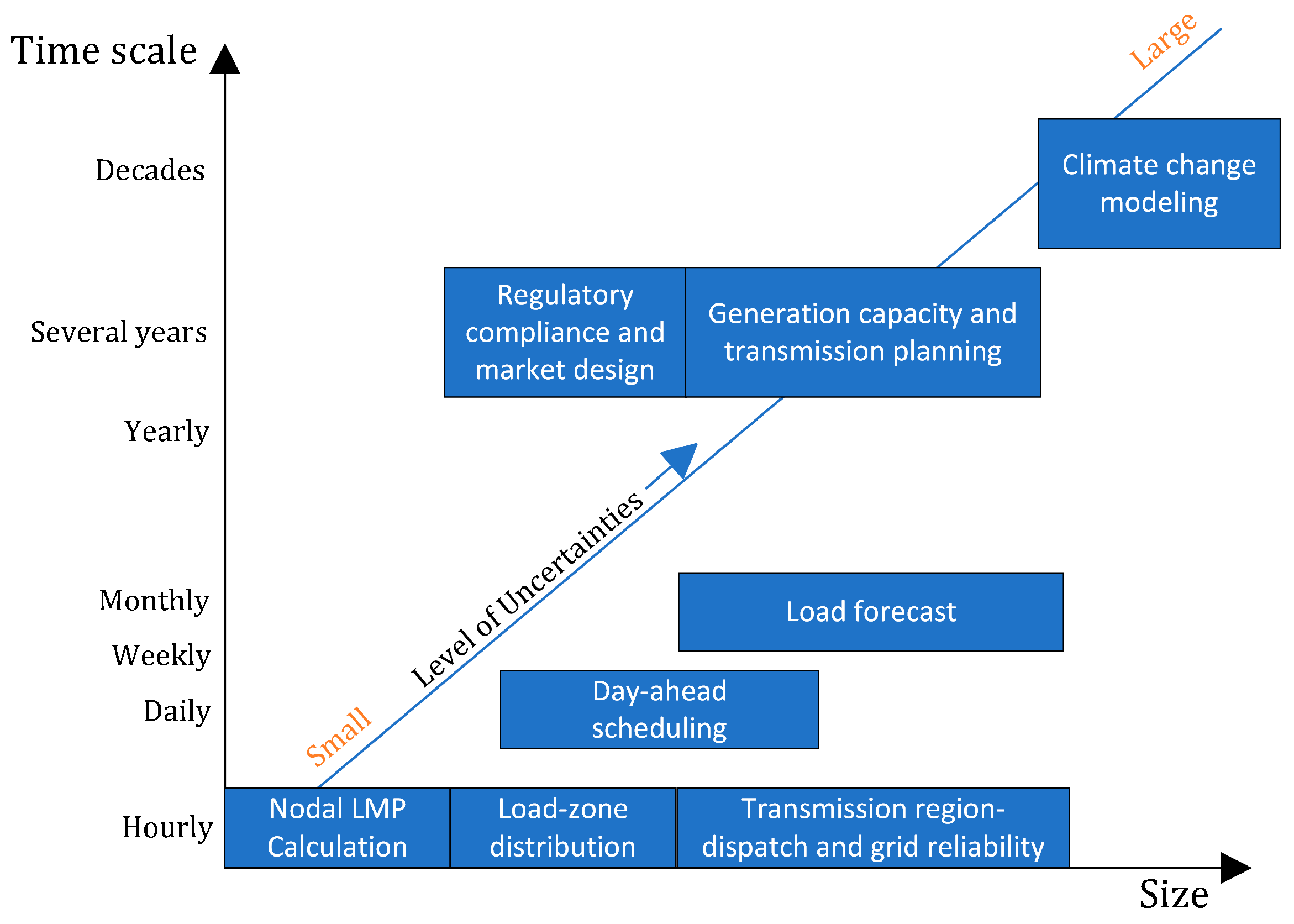

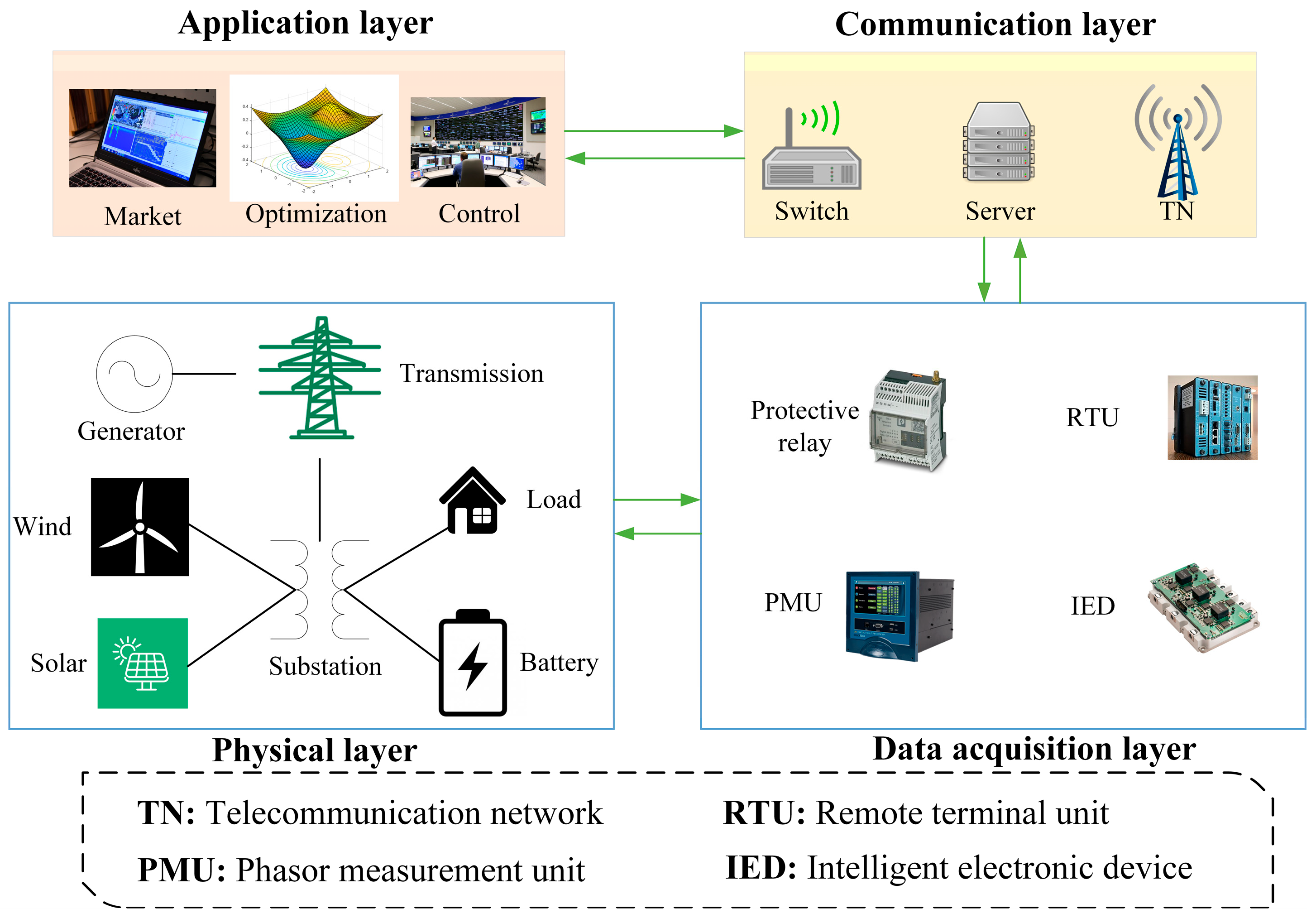
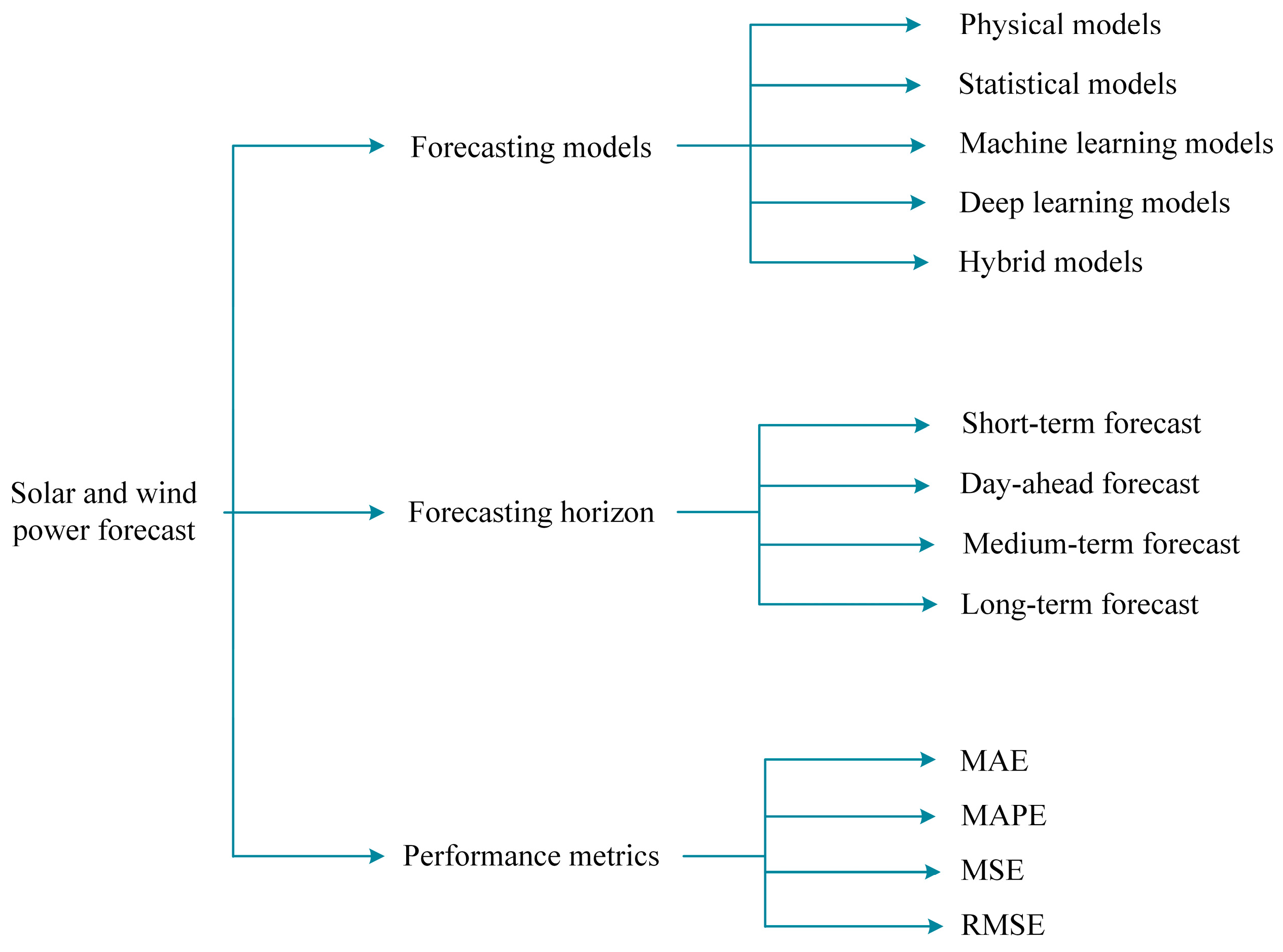
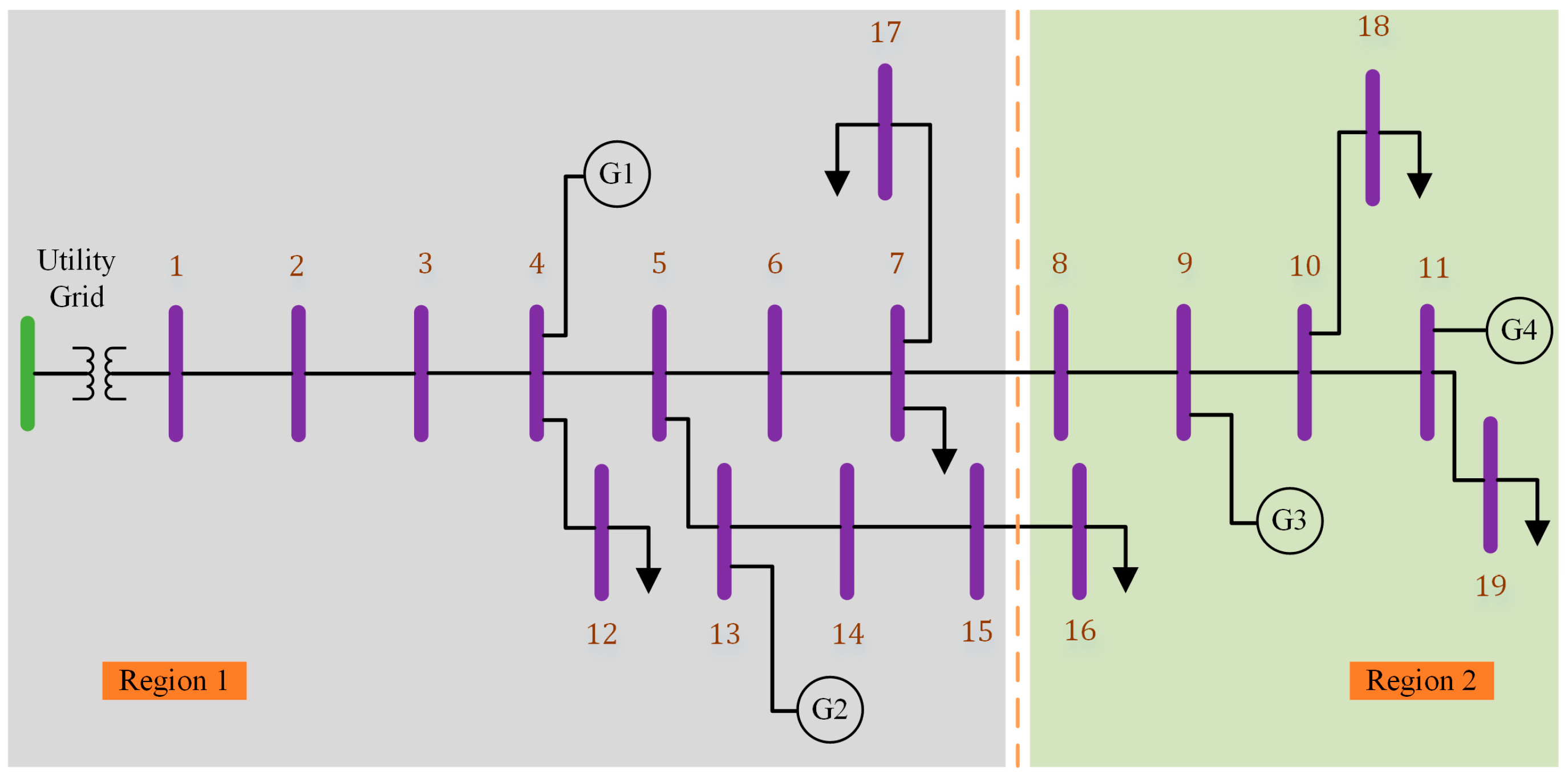
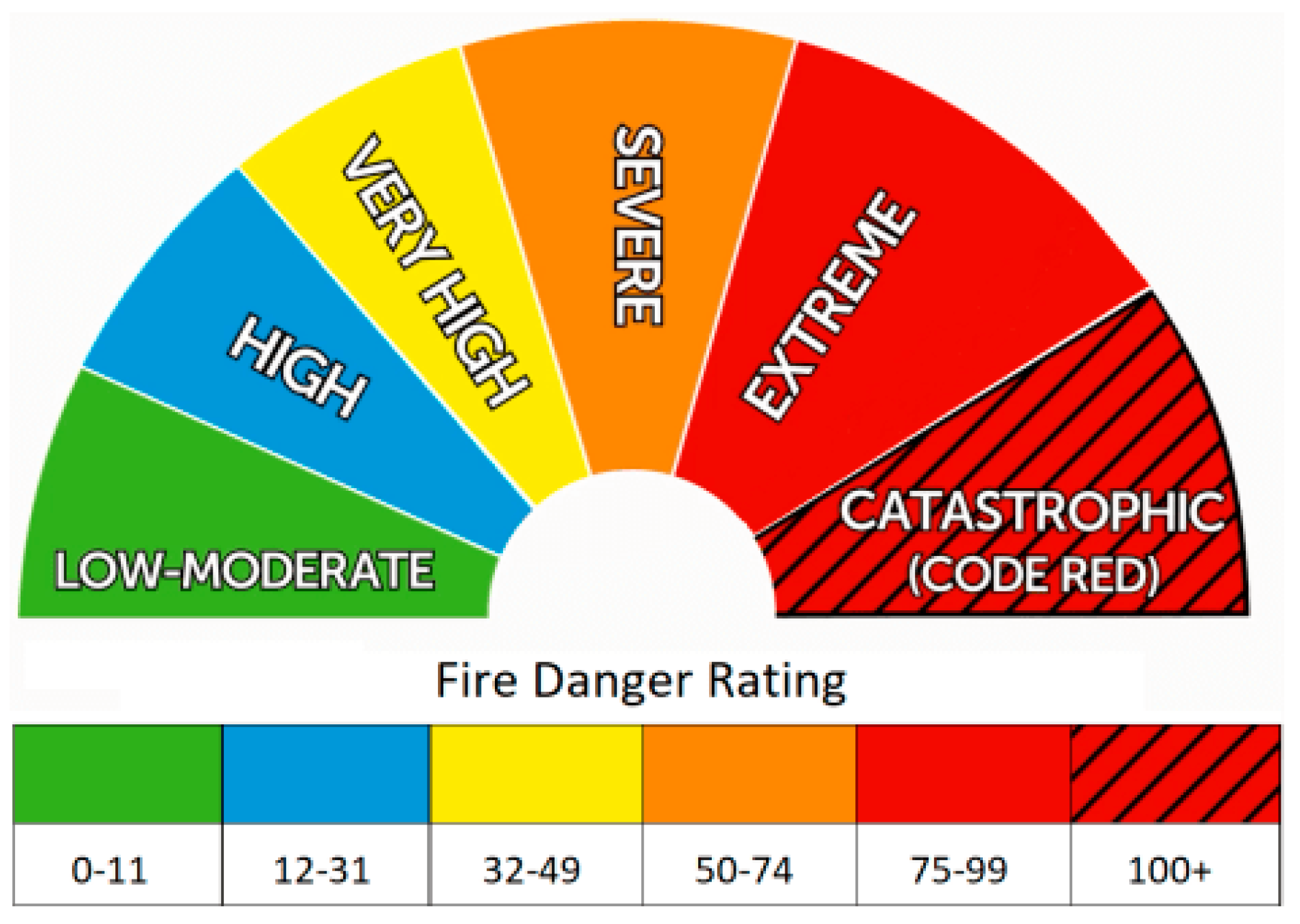

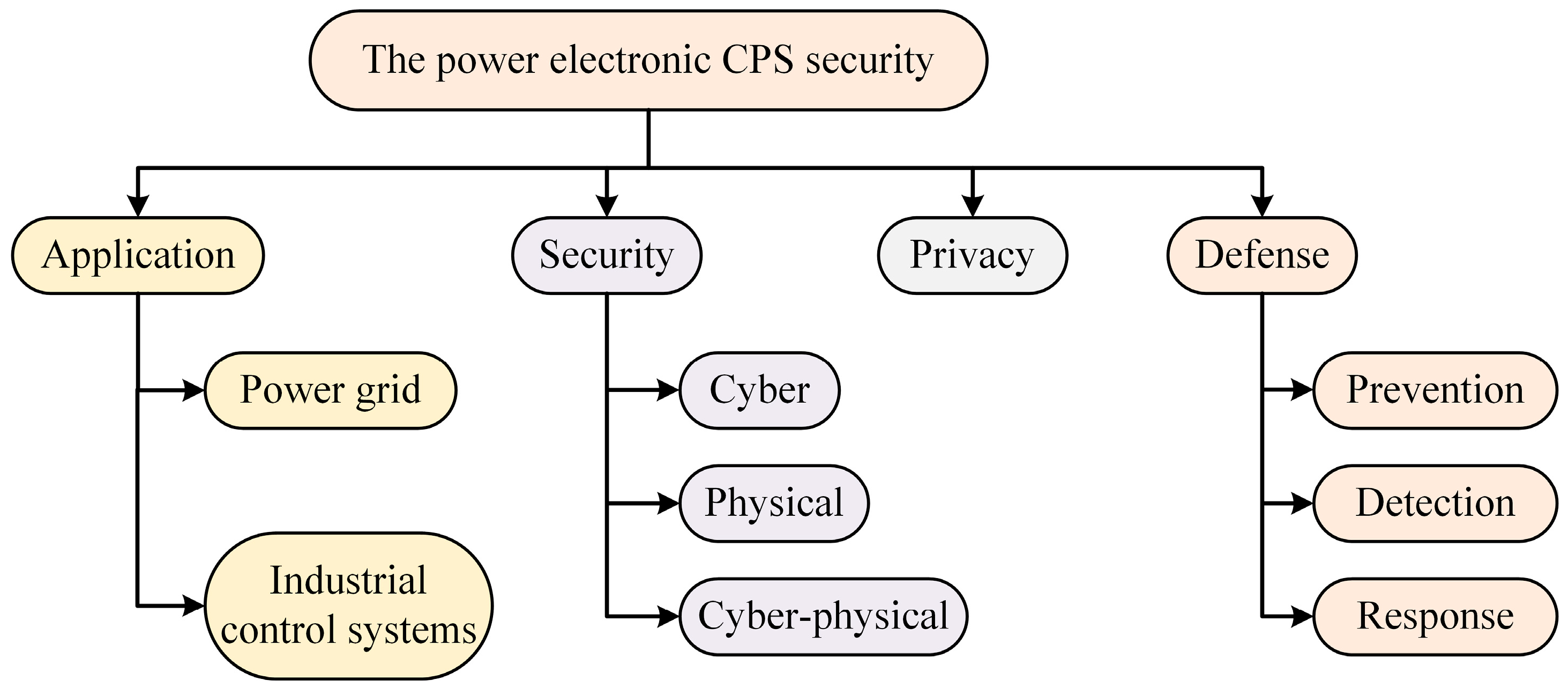
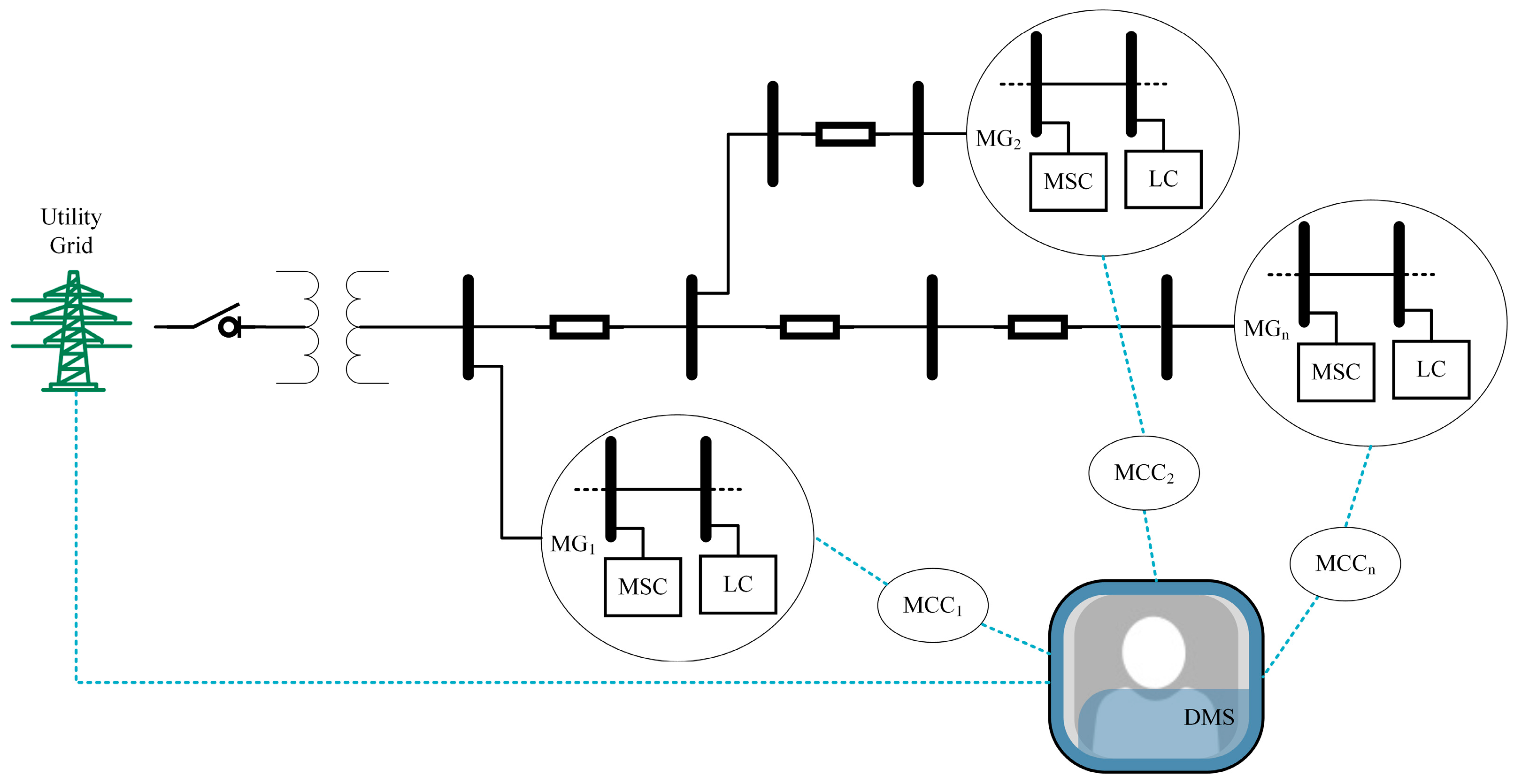
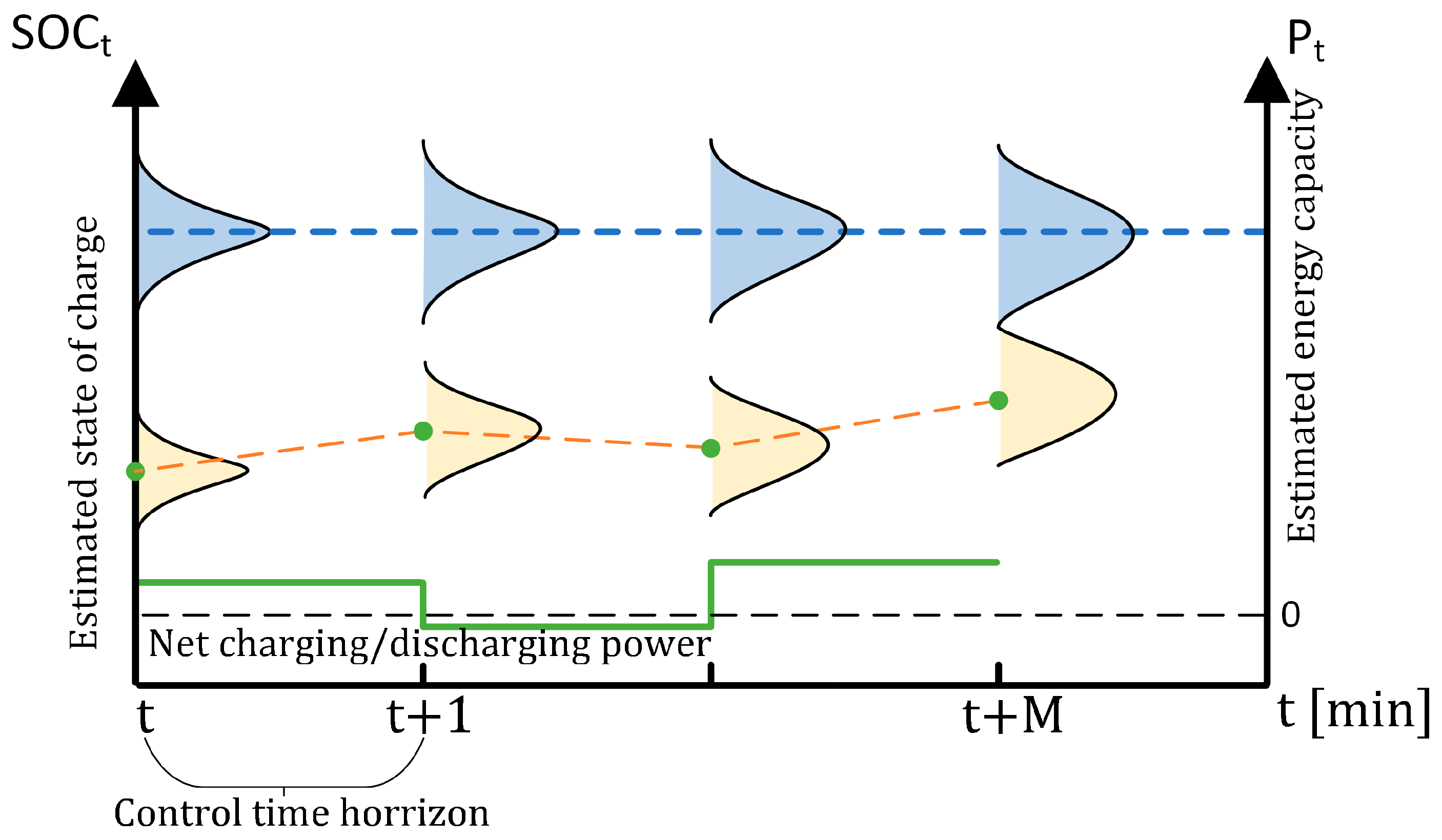


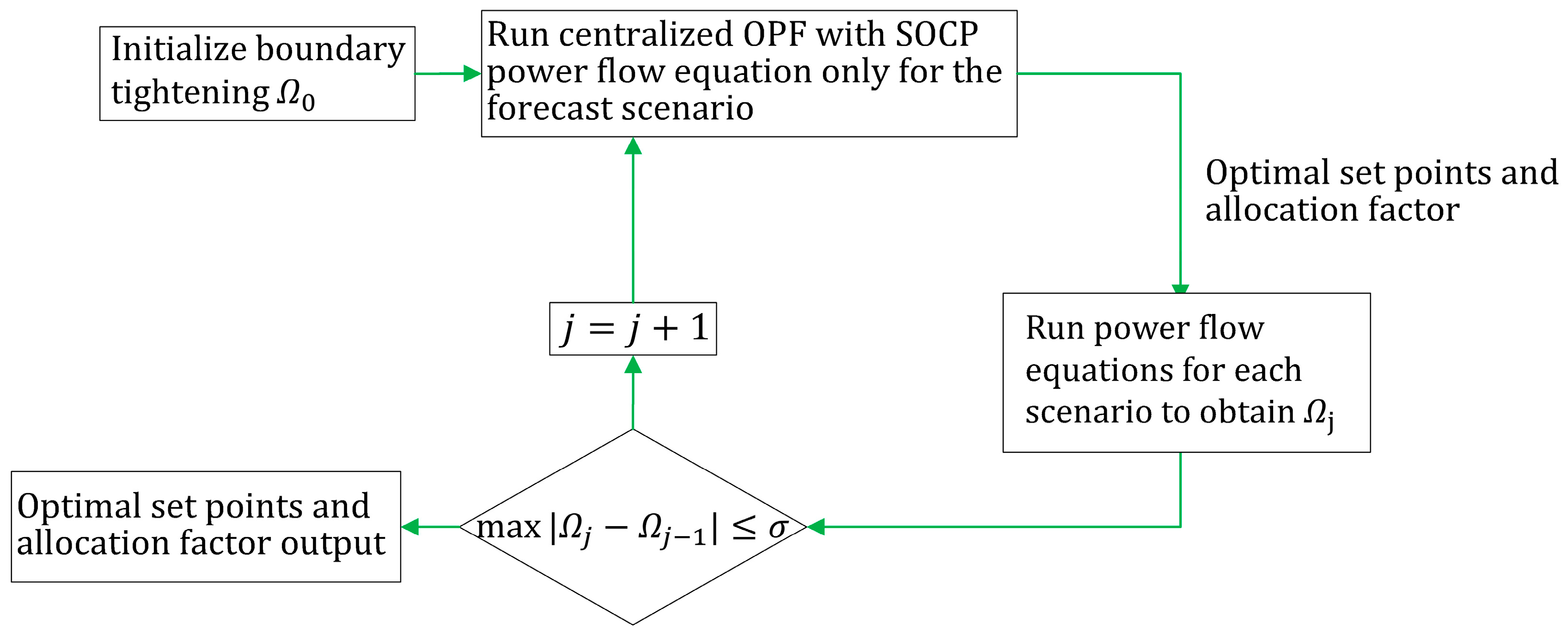
| Reference | Brief Description | Input | Error Metrics |
|---|---|---|---|
| Brahma and Wadhvani, 2020 [64] | The LSTM-based deep learning model is utilized for solar irradiance forecasts. | Solar irradiance | RMSE: 9.788 MSE: 9.721 |
| Liu et al., 2023 [62] | The LSTM-based deep learning model is applied for solar power forecasts. | Time, wind speed, air pressure, humidity, temperature, wind direction, and pyranometer | MSE |
| Voyant et al., 2017 [52] | Machine learning models including SVM and regression trees are applied to predict solar radiation | Solar irradiance | RMSE |
| Torres et al., 2021 [50] | RNN-based deep learning model is applied for short-term PV power forecast | Weather inputs from IoT data set and historical PV generation | R2: 0.988 |
| Hacioğlu, 2017 [65] | Linear regression and Gaussian process regression-based machine learning models are utilized for solar irradiance forecasts. | Wind speed, temperature, humidity parameters, pressure and solar irradiance | MAE: 0.0166 RMSE: 0.0227 |
| Wang et al., 2021 [66] | ANN-based machine learning model is applied to wind power forecast. | Temperature, pressure, wind direction | NMAE: 0.0044 |
| Guo et al., 2010 [67] | ARMA model is utilized for wind speed forecast | Historical value of wind speed | MAE: 0.57 |
| Ferreira et al., 2019 [68] | Hybrid time-series models are applied for short-term wind speed forecasts. | Air pressure, wind speed, wind direction | RMSE: 2.27 |
| Santamaría-Bonfil et al., 2016 [69] | The SVM-based machine learning model is utilized for wind speed forecast | Wind speed, wind direction, humidity, solar radiation, temperature, atmospheric pressure, and heat radiation | NMAE: 0.15 |
| Category | Brief Description | Reference |
|---|---|---|
| MGs | The report discusses the use of transition matrices to model the probability distribution of solar generation and demand at different intervals of the day. It presents heat maps of transition matrices for solar power generation, showing the likelihood of transition from one state to another. | [53] |
| The paper introduces a two-stage operation strategy for IMGs. In the initial stage, day-ahead scheduling is employed to forecast the electricity consumption baseline and regulation capacity for the subsequent day. The second stage focuses on real-time power consumption control, utilizing RegD signals. This second stage consists of two layers: the upper layer manages demand response signals and facilitates electricity exchange among microgrids through an energy-sharing mechanism, while the lower layer executes real-time power consumption control for each individual microgrid. | [62] | |
| The decentralized control approach divides the distribution system into intelligent small grids called microgrids, which can operate autonomously. In island mode, microgrids use voltage and frequency droop control characteristics to share the load automatically without the need for communication systems. In order to reduce the complexity of the network, a decentralized approach using microgrids is suggested. | [110] | |
| This document is a review of microgrid control techniques, specifically focusing on controlling microgrids with distributed RESs in island mode. | [107] | |
| ESS control | The paper proposes explicit and implicit decision methods to address the scheduling problem with a focus on solution robustness and nonparticipative qualities. The explicit decision method assumes affine policies linking decision variables and uncertainty realizations, whereas the implicit decision method explores secure ranges of thermal unit outputs and SOC levels to ensure the feasibility of future economic dispatch solutions. | [111] |
| The paper proposes a risk-based chance-constrained control strategy to optimize the dispatch of energy-constrained ESSs, taking into account the uncertainty associated with estimating the SOC and capacity of the ESSs. The controller coordinates the ESSs to minimize the unscheduled participation of generators and overcome ramp-rate limitations for balancing variability from renewable generation. The paper also introduces a temperature-based DLR approach to integrate ESSs and increase renewable generation. | [109] | |
| The authors introduce an innovative two-stage robust optimization approach that effectively captures the operation of storage devices, accounting for the anticipatory nature of the two-stage setting. The resultant robust counterpart constitutes a mixed-integer trilevel program featuring lower-level binary variables. To tackle the nonconvexity of the problem, the authors suggest employing an exact nested column-and-constraint generation algorithm. | [112] | |
| D-FCAS | This paper proposes a coordinated control strategy for a VPP aiming to enhance load frequency control. The VPP coordinates the allocation of energy and regulation signals among BESSs and HPWHs, which were determined by distribution coefficients derived through multi-objective optimization. | [113] |
| The paper highlights the importance of demand response in enhancing the operational flexibility of power systems and the advantages of industrial loads in providing such a response. However, the discrete power changes in these loads restrict them from offering valuable ancillary services. To address this constraint, the document suggests techniques that empower these loads to offer regulation or load following with the assistance of an onsite energy storage system. The coordination between industrial loads and energy storage is established through a model predictive control approach. | [114] | |
| Researchers in this paper propose an optimization strategy that includes day-ahead scheduling and frequency regulation service to maximize profits and ensure real-time load-following performance. The paper presents a case study that demonstrates the cost-effectiveness and load-following capability of the proposed method compared to industrial loads equipped with only on-site ESS or passive use of solar energy. | [54] |
Disclaimer/Publisher’s Note: The statements, opinions and data contained in all publications are solely those of the individual author(s) and contributor(s) and not of MDPI and/or the editor(s). MDPI and/or the editor(s) disclaim responsibility for any injury to people or property resulting from any ideas, methods, instructions or products referred to in the content. |
© 2024 by the authors. Licensee MDPI, Basel, Switzerland. This article is an open access article distributed under the terms and conditions of the Creative Commons Attribution (CC BY) license (https://creativecommons.org/licenses/by/4.0/).
Share and Cite
Hu, H.; Yu, S.S.; Trinh, H. A Review of Uncertainties in Power Systems—Modeling, Impact, and Mitigation. Designs 2024, 8, 10. https://doi.org/10.3390/designs8010010
Hu H, Yu SS, Trinh H. A Review of Uncertainties in Power Systems—Modeling, Impact, and Mitigation. Designs. 2024; 8(1):10. https://doi.org/10.3390/designs8010010
Chicago/Turabian StyleHu, Hongji, Samson S. Yu, and Hieu Trinh. 2024. "A Review of Uncertainties in Power Systems—Modeling, Impact, and Mitigation" Designs 8, no. 1: 10. https://doi.org/10.3390/designs8010010
APA StyleHu, H., Yu, S. S., & Trinh, H. (2024). A Review of Uncertainties in Power Systems—Modeling, Impact, and Mitigation. Designs, 8(1), 10. https://doi.org/10.3390/designs8010010








